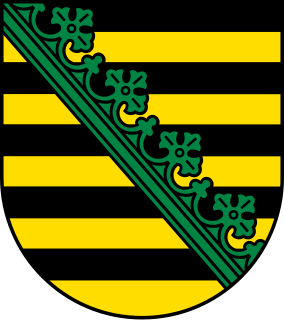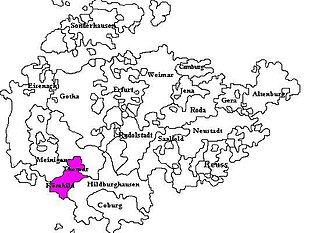This article includes a list of references, related reading or external links, but its sources remain unclear because it lacks inline citations .(November 2018) (Learn how and when to remove this template message) |
This article may be expanded with text translated from the corresponding article in German. (September 2012)Click [show] for important translation instructions.
|
| Ernest | |
|---|---|
 | |
| Duke of Saxe-Hildburghausen | |
| Reign | 1675–1715 |
| Predecessor | New Creation |
| Successor | Ernest Frederick I |
| Born | 12 June 1655 Gotha |
| Died | 17 October 1715 (aged 60) Hildburghausen |
| Spouse | Sophie of Waldeck |
| Issue among others... | Ernest Frederick I Prince Joseph |
| House | House of Saxe-Hildburghausen |
| Father | Ernest I, Duke of Saxe-Gotha |
| Mother | Elisabeth Sophie of Saxe-Altenburg |
| Religion | Lutheran |
Ernest, Duke of Saxe-Hildburghausen (12 June 1655 in Gotha – 17 October 1715 in Hildburghausen) was a duke of Saxe-Hildburghausen.

Hildburghausen is a town in Thuringia in central Germany, capital of the district Hildburghausen.

Saxe-Hildburghausen was an Ernestine duchy in the southern side of the present State of Thuringia in Germany. It existed from 1680 to 1826 but its name and borders are currently used by the District of Hildburghausen.
Contents
He was the ninth but sixth surviving son of Ernest I, Duke of Saxe-Gotha and Elisabeth Sophie of Saxe-Altenburg.
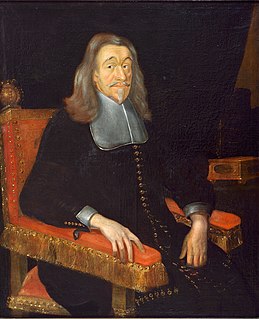
Ernest I, called "Ernest The Pious", was a duke of Saxe-Gotha and Saxe-Altenburg. The duchies were later merged into Saxe-Gotha-Altenburg.
When his father died in 1675, Ernest and his six brothers jointly assumed the government of the duchy; five years later, in 1680, and under the treaty of division of the family lands, he received the towns of Hildburghausen, Eisfeld, Heldburg, Königsberg. Ernest became thereby founder and first duke of Saxe-Hildburghausen. After the death of his brothers Heinrich and Albrecht without male descendants, he took the towns of Sonnefeld and Behringen.

Eisfeld is a town and a municipality in the district of Hildburghausen, in Thuringia, Germany. It is situated on the river Werra, 12 km east of Hildburghausen, and 19 km north of Coburg. The former municipality Sachsenbrunn was merged into Eisfeld in January 2019.

Königsberg in Bayern is a town in the Haßberge district, in Lower Franconia, Bavaria, Germany. It is situated 7 km northeast of Haßfurt, and 31 km northwest of Bamberg.

Sonnefeld is a municipality in the district of Coburg in Bavaria in Germany.
Ernest settled his official residence in Hildburghausen and began the building of his castle. In 1710 he approved the building in his lands of a new city of French Huguenot families, who were driven out after the Edict of Nantes from France.
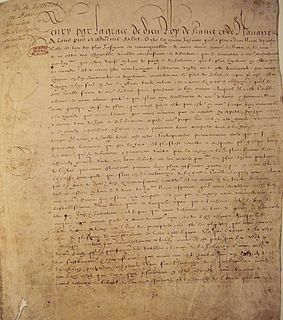
The Edict of Nantes, signed in April 1598 by King Henry IV of France, granted the Calvinist Protestants of France substantial rights in the nation, which was still considered essentially Catholic at the time. In the edict, Henry aimed primarily to promote civil unity. The edict separated civil from religious unity, treated some Protestants for the first time as more than mere schismatics and heretics, and opened a path for secularism and tolerance. In offering general freedom of conscience to individuals, the edict offered many specific concessions to the Protestants, such as amnesty and the reinstatement of their civil rights, including the right to work in any field or for the state and to bring grievances directly to the king. It marked the end of the religious wars that had afflicted France during the second half of the 16th century.
As Master of Cavalry he fought in 1683 in the Battle of Vienna, and 1685 in the conquest of Gran and Neuhaeusel, after this he entered the Dutch States Army as a Colonel with the conquest of Kaiserswerth.
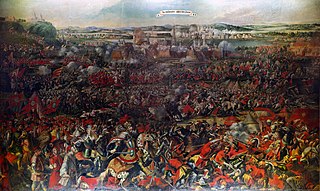
The Battle of Vienna took place at Kahlenberg Mountain near Vienna on 12 September 1683 after the imperial city had been besieged by the Ottoman Empire for two months. The battle was fought by the Habsburg Monarchy, the Polish–Lithuanian Commonwealth and the Holy Roman Empire, under the command of King John III Sobieski against the Ottomans and their vassal and tributary states. The battle marked the first time the Commonwealth and the Holy Roman Empire had cooperated militarily against the Ottomans, and it is often seen as a turning point in history, after which "the Ottoman Turks ceased to be a menace to the Christian world". In the ensuing war that lasted until 1699, the Ottomans lost almost all of Hungary to the Holy Roman Emperor Leopold I.

Esztergom is a city in northern Hungary, 46 kilometres northwest of the capital Budapest. It lies in Komárom-Esztergom county, on the right bank of the river Danube, which forms the border with Slovakia there.

The Siege of Érsekújvár was fought between July 7 and August 17 of 1685, between the besieging Habsburg army and the Ottoman garrison of Érsekújvár, city in what is today Nové Zámky, Slovakia . The Austrian commander, Aeneas de Caprara, invested the city and stormed it on August 17, slaying the entire Ottoman garrison.
In the building of his new residence, Ernest acquired a serious indebtedness of the principality to his brothers, which could not be reduced even by ever larger taxations.



